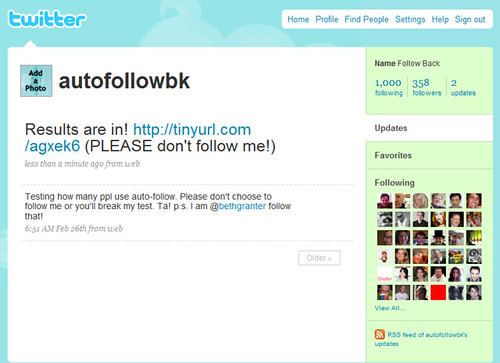Problem: Who knows how many of your followers care about what you say, or have just got autofollow turned on? Worse still, how many of them have just followed you in the hopes that you’ll autofollow them back, or visit their Twitter page and click some of their spammy links, with no regard to who you are? I wouldn’t mind if they did that because they thought I’d honestly find them interesting, but it’s if they’re following me with zero regard to who I am or what my interests are that seems wrong.
Hypotheis and Method: If I set up a test account (@autofollowbk), and follow a load of people, where the test account provides no value to be followed by a real person, we’ll get some stats. Depends who the test account follows though – certain users are more likely to follow back automatically than others. So, to test a specific account (e.g. @bethgranter), I followed everyone who is following that account (I didn’t actually use the bethgranter account because I don’t have 1000 followers – I chose a sample organisation’s account which shall remain nameless), i.e. a certain type of person.
Twitter has a limit to how many people you can follow in one day. I wasn’t sure what that limit was so I limited myself to 500 people per day. In one fell swoop I followed about 480 people. Another 480 were followed the next day and the remaining 40 a couple of days later.

The results: I noticed within ten minutes of following the first 480 people, @autofollowbk had about 50 followers. These people were either trying to ruin my day, or were automatically following everyone that followed them. Nothing innately wrong with that – lots of people find it polite to reciprocate. The numbers of follow backs gradually increased over the next few hours, I assume because some auto follow back systems are on a cycle and don’t react instantly to an account being followed.
What was strange though, is the number of people choosing to follow @autofollowbk without @autofollowbk even following them in the first place! The only reason I can imagine is that those people were taking an individual, call them A, who had been followed by @autofollowbk, and following everyone who was following A, one being @autofollowbk, irrelevant of what @autofollowbk was saying. This might be reasonable if the topic that the follower was talking about was similar to the topic that A was talking about, so they therefore thought that anyone following A would be interested in following them, so they followed A’s followers in order to make them aware of their account. That seems quite reasonable to me, but I guess it could be construed as misusing the medium – you’re not strictly supposed to follow someone on Twitter just to get their attention – you’re supposed to follow them because you want to listen to them. But anyway, rights and wrongs and misuse aside, it’s reasonable that if you follow a similar user’s followers, some of them are likely to find you interesting too. As long as you are interesting and useful in what you tweet that is. The other possibility is that they’re using some bot thingy to randomly follow people, or a bot to automatically follow people following certain accounts.
Anyway, down to the stats:
I’ve used Lessfriends.com to count how many people followed @autofollowbk without being followed in the first place and how many people followed it after being followed first. @autofollowbk followed 1000 users over 3 days. At the end of 3 days,
84 people had chosen to follow @autofollowbk without being followed first = 8% of the total number of people followed by the account
271 people followed @autofollowbk back after being followed first = 27%
That’s an overall rate of 35% disinterested / auto followers, from the total number followed (not the total number following).
154 direct messages were received, all of them clearly automated. That’s 15% using auto DM.
The good news is that 729 people who @autofollowbk followed did not follow back. That’s 73% non auto rate. That drops to 65% when you include the spontaneous disinterested 84 followers. The number of spontaneous disinterested followers will probably go up over time too, bringing the non auto rate down further. So, say we have the original account that the 1000 followers were chosen from. If that account initially followed 2000 people, we’ll assume that 35% of its followers 2000, i.e. 700, are auto followers of one kind or another. So if we got 1,200 followers, and a possible total of 700 are not interested in what we say, then 500 of them are, because 500 of them didn’t automatically follow us back, they actually chose to follow us because they liked what we had to say.
The test account which the 1000 followers were chosen from to follow by @autofollowbk, a total 2000 people were initially followed in the first place, who were all followed due to their apparent interest in a relevant topic, either by tweeting about a subject, by talking about it in their bio, or because they were following a related twitter account. The goal on that account was not only to raise awareness of the account but also to receive a stream of topical conversation from people we followed. Initially all followers were also automatically followed back to be polite, but this has now been turned off in order to reduce the amount of spam in the feed. Some pruning is going to be necessary to weed out the spam, and the @autofollowbk experiment will hopefully help that.
The plan now is to firstly unfollow anyone who was inadvertently followed back who is clearly not interested, i.e. anyone who spontaneously followed @autofollowbk. Then, the plan is to check over all of the mutual followers of @autofollowbk, and if it is not obvious why we would want to follow them, to unfollow them too.
On the subject of auto DMs (automatic direct messages sent in response to being followed), I still haven’t decided. I know in the last few weeks they’ve been getting a lot of criticism as they are commonplace and obviously robotic. However, I think that if worded correctly they don’t constitute spam, since they’re only sent in response to someone signifying their interest in you in the first place. And most of them just say thanks for the follow anyway, which I still think, even if it is an obvious robot, provides a bit of feel-good-factor above not saying anything.
I’ll update this if the figures on the @autofollowbk account change significantly, or do so yourselves in the comments if you notice first.
Also, it’s worth mentioning again that these statistics can’t really be applied too generally, because the group of 1000 users that were chosen were not chosen randomly, but as a selection of a group of people following a specific account.

One response to “The @autofollowbk Twitter experiment results are in!”
Your assumption about the auto follows is incorrect. They pretty much follow back immediately, though I prefer not to use them because of all of the non-family friendly sites. I followed you because I placed a search for follow and you were on the list.
Now follow back — LOL 🙂
Look forward to reading more as your experiment moved forward.
Lea